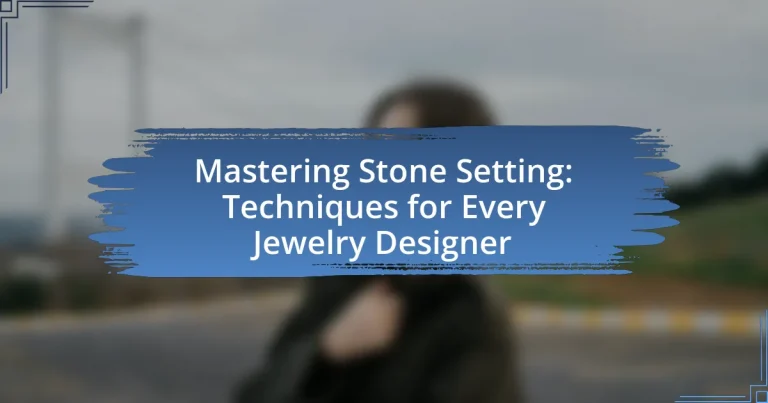Mastering stone setting is a fundamental skill for jewelry designers, encompassing various techniques such as prong, bezel, channel, and pave settings. This article provides an in-depth exploration of these methods, detailing how each technique enhances the aesthetic appeal and durability of jewelry pieces. It also highlights the importance of precision, attention to detail, and the use of appropriate tools in achieving effective stone settings. Additionally, the article addresses common challenges in stone setting and introduces innovative techniques and materials that are shaping the future of jewelry design.

What is Stone Setting in Jewelry Design?
Stone setting in jewelry design refers to the technique of securely placing gemstones or other decorative elements into a piece of jewelry. This process is essential for both aesthetic appeal and the durability of the jewelry, as it ensures that the stones are held firmly in place. Various methods of stone setting exist, including prong, bezel, and pave settings, each offering different visual effects and levels of security. The choice of setting technique can significantly influence the overall design and functionality of the jewelry piece, making it a critical aspect of jewelry craftsmanship.
How does stone setting enhance jewelry pieces?
Stone setting enhances jewelry pieces by securely placing gemstones within the design, thereby increasing their visual appeal and overall value. This technique allows for the optimal display of the stone’s color, brilliance, and cut, which can significantly elevate the aesthetic quality of the jewelry. For instance, a well-set diamond can reflect light more effectively, creating a captivating sparkle that draws attention. Additionally, different stone setting techniques, such as prong, bezel, or pave settings, can influence the style and character of the piece, allowing designers to create unique and personalized jewelry that resonates with individual tastes.
What are the different types of stone settings used in jewelry?
The different types of stone settings used in jewelry include prong setting, bezel setting, channel setting, pave setting, and tension setting. Prong setting involves metal claws that hold the stone in place, allowing maximum light to enter the gem, enhancing its brilliance. Bezel setting encases the stone in a metal rim, providing a secure fit and a modern look. Channel setting features stones set in a groove between two metal strips, ideal for creating a continuous line of gems. Pave setting uses small stones set closely together with minimal visibility of the metal, creating a sparkling surface. Tension setting holds the stone in place through the pressure of the metal band, giving the illusion that the stone is floating. Each setting type serves specific aesthetic and functional purposes in jewelry design.
How do various settings impact the overall design and aesthetics?
Various settings significantly influence the overall design and aesthetics of jewelry by determining how stones are displayed and interact with light. For instance, a prong setting elevates stones, allowing maximum light exposure, which enhances brilliance and sparkle, while a bezel setting encases stones, providing a sleek, modern look that emphasizes the stone’s color and shape. Additionally, the choice of setting can affect the perceived size of the stone; for example, a halo setting can create an illusion of a larger center stone by surrounding it with smaller stones. These design choices are crucial as they not only affect the visual appeal but also the overall style and functionality of the piece, catering to different consumer preferences and trends in jewelry design.
Why is mastering stone setting important for jewelry designers?
Mastering stone setting is crucial for jewelry designers because it directly impacts the quality, durability, and aesthetic appeal of their creations. Effective stone setting techniques ensure that gemstones are securely held in place, preventing loss or damage, which is essential for maintaining customer satisfaction and brand reputation. Furthermore, a well-executed setting enhances the visual presentation of the jewelry, allowing the stones to shine and attract attention. According to a study published in the “Journal of Gemology,” proper stone setting techniques can increase the perceived value of a piece by up to 30%, highlighting the importance of this skill in the jewelry design industry.
What skills are essential for effective stone setting?
Essential skills for effective stone setting include precision, attention to detail, and manual dexterity. Precision is crucial as it ensures that stones are set accurately within their mounts, preventing damage and ensuring aesthetic appeal. Attention to detail allows the stone setter to identify imperfections in both the stones and the settings, which is vital for achieving high-quality results. Manual dexterity is necessary for handling small tools and stones, enabling the stone setter to work with the intricate designs often found in jewelry. These skills collectively contribute to the overall quality and durability of the finished piece.
How does stone setting influence the durability of jewelry?
Stone setting significantly influences the durability of jewelry by securing gemstones in a manner that protects them from damage and wear. Proper stone setting techniques, such as bezel, prong, or channel settings, determine how well the stones are held in place and shielded from external forces. For instance, a bezel setting encases the stone in metal, providing robust protection against impacts, while prong settings expose more of the stone, making it more susceptible to chipping or loosening. Research indicates that jewelry with well-executed stone settings can withstand daily wear better, as evidenced by studies showing that pieces with secure settings have a lower incidence of stone loss or damage over time.

What are the Key Techniques in Stone Setting?
The key techniques in stone setting include prong setting, bezel setting, channel setting, and pave setting. Prong setting involves securing a stone with metal claws, allowing maximum light exposure, which enhances brilliance. Bezel setting encases the stone in a metal rim, providing a secure hold and a sleek appearance. Channel setting arranges stones in a row within a metal channel, creating a continuous line of gems, while pave setting uses small stones set closely together to create a sparkling surface. Each technique serves distinct aesthetic and functional purposes in jewelry design, ensuring both beauty and durability.
How do you perform a prong setting?
To perform a prong setting, first, secure the stone in place using metal prongs that hold the stone’s edges. Begin by creating a setting with a base that accommodates the stone’s size, then position the stone in the center. Next, use a tool to gently bend the prongs over the stone, ensuring they grip the edges without obscuring the stone’s facets. This technique is widely used in jewelry making, as it allows maximum light to enter the stone, enhancing its brilliance. The effectiveness of prong settings is evidenced by their prevalence in engagement rings, where they are favored for showcasing diamonds and other gemstones prominently.
What tools are necessary for prong setting?
The tools necessary for prong setting include a prong pusher, pliers, a setting bur, and a magnifying loupe. The prong pusher is used to push the prongs over the stone securely, while pliers help in bending and adjusting the prongs. A setting bur is essential for creating the initial seat for the stone, ensuring it fits properly. Lastly, a magnifying loupe allows for detailed inspection of the setting process, ensuring precision and accuracy. These tools are fundamental in achieving a successful prong setting in jewelry design.
What are the common mistakes to avoid in prong setting?
Common mistakes to avoid in prong setting include inadequate prong height, improper prong spacing, and insufficient prong thickness. Inadequate prong height can lead to stones being set too low, risking damage or loss. Improper prong spacing may cause uneven support, which can result in the stone becoming loose or falling out. Insufficient prong thickness can compromise the strength of the setting, making it vulnerable to wear and tear. Each of these mistakes can significantly affect the durability and appearance of the jewelry piece, emphasizing the importance of precision in prong setting techniques.
What is the process for bezel setting stones?
The process for bezel setting stones involves creating a metal rim that encircles the stone, securing it in place. First, the jeweler measures and cuts a strip of metal to form the bezel, ensuring it matches the stone’s dimensions. Next, the bezel is shaped and soldered to a base or backing plate. After that, the stone is placed into the bezel, and the metal is carefully pushed over the stone’s edge using specialized tools, securing it firmly. Finally, the setting is polished to enhance its appearance. This technique is widely used due to its ability to protect the stone while providing a sleek, modern look.
How do you prepare the metal for bezel setting?
To prepare the metal for bezel setting, first, cut the metal sheet to the desired size and shape, ensuring it is slightly larger than the stone to accommodate the bezel. Next, file the edges to create a smooth surface, which helps in achieving a tight fit around the stone. After filing, use a bezel roller or burnisher to shape the metal around the stone, ensuring it conforms closely to its contours. This process is crucial as it secures the stone effectively and enhances the overall aesthetic of the piece. Proper preparation of the metal is essential for a successful bezel setting, as it directly impacts the durability and appearance of the final jewelry piece.
What techniques ensure a secure bezel setting?
To ensure a secure bezel setting, jewelers utilize techniques such as precise measurement, proper metal thickness, and effective burnishing. Precise measurement guarantees that the bezel fits the stone snugly, preventing movement. Using an appropriate metal thickness, typically between 0.5mm to 1mm, provides sufficient strength to hold the stone securely. Effective burnishing involves pushing the bezel metal over the stone’s edge, creating a tight grip that enhances security. These methods are widely recognized in the jewelry industry for their effectiveness in maintaining the integrity of the stone within the bezel setting.

What Advanced Techniques Should Jewelry Designers Learn?
Jewelry designers should learn advanced techniques such as micro-pave setting, channel setting, and tension setting. Micro-pave setting involves using tiny gemstones set closely together, requiring precision and skill to create a seamless look, which enhances the overall aesthetic of the piece. Channel setting allows for a row of stones to be set within a channel, providing a secure and elegant way to showcase multiple stones, often used in wedding bands. Tension setting utilizes the inherent strength of the metal to hold a stone in place, creating a striking visual effect that emphasizes the stone’s beauty. Mastery of these techniques not only elevates a designer’s craftsmanship but also expands their creative possibilities in jewelry design.
How can you incorporate pave setting into your designs?
To incorporate pave setting into your designs, utilize small gemstones set closely together to create a continuous surface of sparkle. This technique enhances the visual impact of the piece while allowing for intricate patterns and shapes. Pave setting is commonly used in rings, bracelets, and earrings, where the arrangement of stones can complement the overall design. The precision required for this setting ensures that each stone is securely held in place, which is critical for durability and aesthetic appeal. Historical examples, such as the use of pave setting in 18th-century jewelry, demonstrate its enduring popularity and effectiveness in elevating design.
What are the steps to achieve a flawless pave setting?
To achieve a flawless pave setting, follow these steps: First, select high-quality stones that are uniform in size and shape to ensure a consistent appearance. Next, prepare the metal surface by creating a smooth and clean base, which allows for better adhesion and stability of the stones. Then, use a precise setting tool to create evenly spaced seats for each stone, ensuring they fit snugly without gaps. After placing the stones, secure them by pushing the surrounding metal over the edges of each stone, which locks them in place. Finally, inspect the setting for any loose stones or irregularities, and polish the piece to enhance its shine and overall appearance. These steps are essential for achieving a professional and aesthetically pleasing pave setting in jewelry design.
What challenges might arise with pave setting and how can they be overcome?
Pave setting presents challenges such as stone loosening, difficulty in cleaning, and potential for damage to the stones. To overcome stone loosening, jewelers can ensure proper prong placement and secure settings during the initial installation. For cleaning difficulties, using ultrasonic cleaners with caution and employing soft brushes can help maintain the integrity of the setting while ensuring cleanliness. To prevent damage, selecting durable stones and employing protective settings can mitigate risks. These strategies enhance the longevity and appearance of pave-set jewelry.
What innovative stone setting techniques are emerging in the industry?
Innovative stone setting techniques emerging in the jewelry industry include the use of 3D printing for custom settings, tension settings that hold stones without traditional prongs, and the incorporation of advanced adhesives for secure placements. 3D printing allows for intricate designs that were previously impossible, enabling designers to create unique settings tailored to specific stones. Tension settings, which utilize the inherent strength of the metal to hold the stone in place, provide a modern aesthetic while maximizing light exposure to the gem. Additionally, advanced adhesives offer a secure alternative to mechanical settings, allowing for more creative freedom in design. These techniques reflect a shift towards more contemporary, versatile, and efficient methods in stone setting.
How do modern technologies influence stone setting methods?
Modern technologies significantly enhance stone setting methods by introducing precision tools and advanced materials that improve accuracy and efficiency. For instance, computer-aided design (CAD) software allows jewelry designers to create detailed models of settings, ensuring a perfect fit for each stone. Additionally, laser technology enables precise cutting and engraving, which minimizes the risk of damaging the stones during the setting process. Furthermore, 3D printing facilitates the rapid prototyping of intricate designs, allowing for innovative settings that were previously difficult to achieve. These advancements collectively lead to higher quality craftsmanship and reduced production times in the jewelry industry.
What are the benefits of using alternative materials in stone setting?
Using alternative materials in stone setting offers several benefits, including enhanced creativity, cost-effectiveness, and sustainability. These materials, such as resin, glass, or synthetic stones, allow designers to explore unique aesthetics and innovative designs that may not be achievable with traditional gemstones. For instance, synthetic stones can mimic the appearance of natural gems while being significantly less expensive, making them accessible for a wider audience. Additionally, alternative materials often have a lower environmental impact compared to mining natural stones, aligning with the growing demand for sustainable practices in the jewelry industry. This shift not only caters to eco-conscious consumers but also encourages designers to experiment with new textures and colors, ultimately enriching the jewelry-making process.
What are the best practices for troubleshooting common stone setting issues?
The best practices for troubleshooting common stone setting issues include assessing the fit of the stone, checking for proper alignment, and ensuring the setting is secure. First, evaluate whether the stone fits snugly in the setting; a loose fit can lead to stones falling out. Next, verify that the stone is aligned correctly within the setting, as misalignment can affect the overall appearance and stability. Finally, inspect the prongs or bezel for any signs of weakness or damage; a secure setting is crucial for the longevity of the piece. These practices are supported by industry standards, which emphasize the importance of proper stone placement and secure settings to prevent loss or damage to gemstones.


